by Winding Pathways | Feb 8, 2018 | Geology/Weather, Nature
Ice is a miraculous substance. Actually, it is water that is so amazing. Ice is just one of its three phases.
Water is essential for life and one of its unusual characteristics is how it behaves when its temperature drops. Like most substances water contracts as it gets colder, but unlike other substances, it reaches maximum density at 39 degrees Fahrenheit and then expands as it gets colder. Finally, when it freezes at 32 degrees Fahrenheit it expands.
That’s huge! If Ice were denser than water, it would sink to the bottom of a lake or pond. The surface would continue to freeze and sink until by mid-winter the lake would be all ice. Few creatures could live there.
Instead, when water freezes it expands and gets lighter. It floats on the colder water beneath and insulates the water, so it doesn’t freeze all the way to the bottom. Ice is merely a veneer floating on water, enabling life in the liquid below it.
It might be 20 below zero in the air above the ice but down in the water a fish basks in the relative warmth of water in the 30s.
When lake ice gradually cools as fall’s temperature drops a beautiful result happens in some years. On one cold, clear, calm night the lake will form a layer of crystal clear ice several inches thick. It’s hard and usually safe to walk on.
The walk reveals amazing patterns of cracks and fractures. Clear ice gives a lake walker the sensation of striding on air with a clear view to the bottom beneath the feet. For an idea of the beauty of ice, enjoy these photos taken at Cedar Lake, Denville, New Jersey, in January 2018.
-
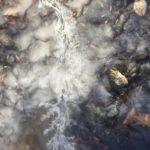
-
Bald Hill Ice
-

-
Ice Fractures
-

-
Fascinating patterns in the ice.
-
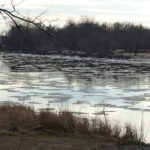
-
Ice expands as its temperature drops, so it floats!
-
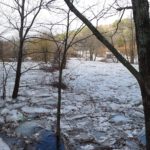
-
Photo by Bob Fehsinger
-
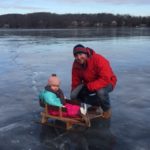
-
Learn to enjoy lake ice safely.
by Winding Pathways | Feb 1, 2018 | Nature, Reflections/Profiles
Winter is the season of cold and darkness but there’s no reason to stay inside. It’s an outstanding time to enjoy the yard, a wetland, or a nearby woods, and these places are even more fascinating after dark than they are by day. Just use your night vision.
Winding Pathways encourages everyone to bundle up and go outside, especially after January or February’s darkness descends. Perhaps coyote songs or the haunting call of a barred owl will greet an intrepid nighttime listener.
There are some ways to best enjoy the darkness. Forget the flashlight. Well, maybe tuck it into a pocket but mostly keep it off. The best way to degrade night vision is using artificial light. Better to learn how to see in the dark.
Color Deficiency Can Help with Night Vision
Rich Patterson, a co-owner of Winding Pathways is lucky, sort of. He is unable to see the color red well. He’s not color blind as he can see blue, yellow, green, and some red shades, but he doesn’t see red as people with normal color vision so. For some reason, folks with color deficiency vision often have an outstanding ability to see after dark, and Rich enjoys his night vision, is often outside after dark, and hardly ever uses a flashlight.
There’s more to seeing after dark than having a color deficiency and better than average night vision. Everyone can use these techniques to negotiate the night and their homes at night without a flashlight.
Relax the eyes. Forget peering for detail, like the texture of a tree’s bark. Rather look out of the edges of the eyes for patterns that indicate a tree, rock, lawn, or some other object. Once the eyes are trained to work well at night it’s amazing how easy it is to walk a forest path, without a flashlight on a dark night. Or navigate your home in the dark and when the electricity goes off.
Foot Gear for Outdoor Walking
When outside, wear soft-soled shoes or in warm months, go barefoot. Thick hard-soled shoes, like hiking boots, make it impossible to feel the ground’s texture. Softer, pliable soles help a walker feel the trail. Native Americans knew this well and felt their way through dark forests through the soles of their moccasins.
It helps to mute electric lights in the house before venturing outdoors after dark. It takes a few minutes in darkness for eyes to adjust and allow more light to strike the retina.
Moon Shadows

Full Moon Walk New Year’s Night
There is a surprising amount of light on a dark night especially in winter with snow on the ground. Even in the dark of the moon, stars cast enough light on a clear night for an adept human to walk without a flashlight. With a waxing or even waning full moon, plenty of light is cast on the ground for us to see. The moon’s reflection even casts shadows: Moon shadows!
Pre-Dawn Labyrinth Walking
Since late December 2017, Marion has walked the Phoenix Harmony Labyrinth every day and mostly in the early morning. In cold, wind, full-moon and dark of the moon, fog, and snow, she has quietly trod through the snow, watched the stars, noted animal tracks and generally enjoyed this interlude in the dark.
Cave Dark is Real Dark
An interesting experience is taking a cave tour. Visit Carlsbad Caverns, Mammoth Cave, or nearly any other cave and invariably the guide will gather everyone and turn off the lights. Down in a cave there is no light at all. When there’s no light it’s impossible to see, but fortunately, a backyard or woods at night is much lighter than the depths of a cavern, so seeing is possible.
Go outside after dark and have fun.
by Winding Pathways | Nov 30, 2017 | Nature, Reflections/Profiles, Wonderment
Carole Teator: Thank you for inviting my story. And thank you for the column on the catalpa tree. I do enjoy them, particularly when they are in bloom.
This is a story of losing a tree. Carole shares that it “… helped me realize how deeply one can mourn the loss of a non-sentient being.”
Cottonwood
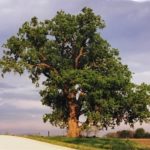 “I recently came across the attached photo of a cottonwood tree that I once knew and this old friend has been on my mind since. It grew along Austin Road, north of Marion, and I came to know it when visiting friends who live nearby. When I could, I would walk to visit the tree and eventually photographed it in every season. It was huge—perhaps 20 feet in circumference?—and it stood alone, between a field and the road. Nearby is a small woodland, the proximity of which may have made the cottonwood seem even more solitary at the side of the road.
“I recently came across the attached photo of a cottonwood tree that I once knew and this old friend has been on my mind since. It grew along Austin Road, north of Marion, and I came to know it when visiting friends who live nearby. When I could, I would walk to visit the tree and eventually photographed it in every season. It was huge—perhaps 20 feet in circumference?—and it stood alone, between a field and the road. Nearby is a small woodland, the proximity of which may have made the cottonwood seem even more solitary at the side of the road.
“One day, one of my friends who lived near the tree dropped me off at the Cedar Rapids Airport. A terrible storm blew in, delaying my flight and making me very concerned about my friend and her young son, who I knew would be driving on Highway 13 at the height of the storm. When I was able, I called to check on them. She said they were fine, but that the old cottonwood had blown over in the storm. Shock and sadness washed over me, and I was as surprised by this visceral reaction as much as I was by the news. I mean, it was a tree I only saw every few weeks and I only had known it a few years of its life. But it seemed a connection to the past and a sentinel of beauty and solitude that was now gone. I had connected to this tree more than I had understood, or even understand now. I continue to mourn its passing, but I am so grateful for the photos I took of it that remind me of its beauty and grace.”
Catalpa
Bev Hannon: “Your Sunday article on catalpa trees brought back lots of memories. We had two trees between the sidewalk and street at the house I grew up in, in Manchester, IA. I loved those trees and founds all kinds of way to use the blossoms and beans as a child. I think I even used to climb the trees, ‘though not successfully. I held “tea parties” in the shade under them, serving the early beans in my little tea dishes and of course, decorating my table with the blossoms.
“Unfortunately, the trees are long gone, as well as the house I grew up in. It burned down, and someone set up a double wide trailer facing the other street (corner lot), not West Marion St., so even my old address is gone. 🙁 But the memories live on.
“Thanks for your good words for Catalpas.”
The Ramsey Table
Marion Patterson: While clearing out the attic, recently, I came across “The Ramsey Table”. This was a roughly fashioned coffee-type table my folks made shortly after we were married and brought to us in Iowa. Dad had found an 18″ wide plank from the home we lived in Goffstown, NH. Purportedly, (one of) the oldest in town. The home did pre-date the Revolution and was for sure haunted! One family that lived there was “The Ramseys.” Much to my folks’ bemusement, a friend and I concocted all sorts of adventures surrounding this unknown family. Thus the name of the table.
Mom placed a variety of sentimental objects in the little shadow box cubbies that Dad had made. Many of these I later replaced as their meaning dissolved. Glued-down pennies of significant dates like when we were born, graduated high school and college, got married remained. And, a little memento of “Baby Magaret” a long-lost relative from 1878 Chambersburg, PA, who died in infancy.

Square Nail Holes
It was time to dismantle The Ramsey Table as we have never had a good place to display and use it. I did so reflectively. A further look at the plank revealed some interesting features. It was a decades-old pine tree with three knots across the middle. As a young tree, it grew fairly fast in New England soil in years when sufficient moisture helped it along. Later the rings grew closer together until they were indistinguishable. Revealing less moisture and more competition perhaps as it grew.
Most interesting to us were the widely spaced square nail holes! Their presence and configuration confirmed that this was an old piece of lumber. So, we have kept the plank and are thinking about the best way to honor it and Mom and Dad’s gift of The Ramsey Table.
The Treehouse
Rich Patterson
When I was eight or ten years old Dad helped a friend and me construct a treehouse in a multibranched gray birch tree that grew behind our house in New Jersey. It was mostly platform four or five feet above the ground.
Growing nearby was a tall maple on high ground overlooking Cedar Lake. It was easy to climb trees with horizontal branches perfectly spaced apart. My friend and I carried boards way up in the tree, perhaps 40 feet above the ground, and we made a platform there. We even made a flagpole and hoisted it above the tree’s top.
Grandma Zieger lived close by and saw us high in the tree and alerted Mom and Dad, as a fall from that height would be serious. They were unworried, as they thought we were in the low tree. Only later did they discover the lofty perch and discouraged its use.
Pacific Madrone
Rich Patterson
In the late 1960s, I found myself in the army as a neophyte infantryman. For a while, I was stationed at Fort Lewis, Washington on the south end of Puget Sound in the rainforest, a land of giant trees.
One evening my company was told to gear up and, squad by squad, we climbed aboard helicopters. Soon we took off in the darkness and not long later landed. A lieutenant told us to jump out and make a defensive perimeter. We could expect an attack at dawn. It was a big war game, the blue army vs. the green one.
So, we formed sort of a circle as best we could in the darkness and took turns on guard duty all night. Two of us would be awake for an hour while the rest slept. At the end of an hour, the guard duty guys would wake up the next shift, and so on.
I ended up with the dawn shift and got poked awake around 4:30 in the morning. With a partner, we peer outward searching for danger, but we could see nothing. It’s true that the darkest hour is just before dawn, but as the earth turned toward the sun the land lightened and gradually I could make out the trunks of huge Douglas fir and cedars. Beneath them was a tree so unusual it riveted my eyes. Small and twisted, it had large deciduous type leaves and looked like it belonged in the tropics. I’d never been in the rainforest before and was so fascinated I stood up to get a better look.
Instantly an M-16 spit out a clip’s worth of blanks. In those days blanks had bullets made of compressed paper. Several splattered on my chest and hurt but did no damage. Within seconds and army “referee” approached, put a colorful tag on me and pronounced me dead. I was told to walk back to the LZ (helicopter landing zone).
It was the Pacific Madrone that helped me realize that curiosity about nature can be dangerous.
Old Henry
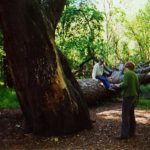
Old Henry
R and M Patterson: Folks who have visited Indian Creek Nature Center over the decades remember fondly “Old Henry”.
This large silver Maple along Indian Creek just off the Sac and Fox Trail, grew up when the Center was a farm, was flooded regularly, thrived in the dense moist soil and was home to many animals. Its girth beckoned visitors to wrap multiple arms around its massive trunks and cool off in its shade. Kids and adults alike loved Old Henry. Cedar Rapidians returning for the Holidays often made pilgrimages to see Old Henry and reminisce about their adventures there.
So, many mourned when its branches started to fall off, when winds toppled large sections of its trunk and when it finally, keeled over from age. Its limbs lay scattered about and kids still climbed all over them until these rotted away. But, Old Henry’s passing opened up space for new Henrys to grow. Some are good sized. Birds and mammals have returned to nest and rest. Insects and worms still ply the soils.
Perhaps one of the most touching tributes over the years was that each late fall, some kindly soul would leave a garland around Old Henry with a few tidbits for the animals. Even as Old Henry became littler and littler, this anonymous person would trek out to Old Henry and leave love offerings. So, Rich was moved when this week he walked past Old Henry, now a tiny stump, and saw a garland wrapped around the remains and a few tidbits for the animals. A fitting tribute to an old friend. Thank you.
by Winding Pathways | Nov 9, 2017 | Nature, Trees/Shrubs
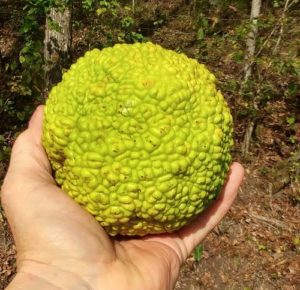 This fall we’ve noticed Osage Orange fruits for sale in grocery stores and roadside stands. They are fascinating and have a delightful fresh citrus scent.
This fall we’ve noticed Osage Orange fruits for sale in grocery stores and roadside stands. They are fascinating and have a delightful fresh citrus scent.
These are often called Hedge Apples, and many people call the tree they grow on Hedge. More properly the tree is called an Osage Orange and the fruits are Osage Oranges. To add confusion some people, call the tree Bodark because its springy tough wood was once used to make bows.
The Osage Orange once lived in a relatively small area of Texas and Oklahoma but because it is tough, drought resistant, and thorny it was commonly planted in places outside its native range. The tree’s branches twist in many directions with thorn-studded twigs. When planted in a row, the trees created a living fence that cattle wouldn’t cross. In the days before barbed wire was invented millions of Osage Oranges were planted for fences.
The wood is hard and heavy and is outstanding for firewood, but cutting it is challenging because of all the thorns.
Does a Hedge Apple in the basement keep insects away? Many people think so and annually buy or collect a few. We think it’s an ineffective way to keep out insects and find caulking entry points better for excluding bugs from our home.
In recent years an oil extracted from hedge apples has been used in shampoo and hair conditioners, and many people love the product. It is marketed as POMIFERA in honor of the tree’s Latin name Maclura pomifera. Todd Johnson, a native Bloomfield, Iowan, has cashed in on the Hedge Apple industry.
Hungry squirrels sometimes eat the seeds hidden inside hedge apples and livestock sometimes dine on them but they are inedible to humans.
There’s no harm in putting a few hedge apples in the basement but don’t count on them to keep away bugs.
by Winding Pathways | Nov 2, 2017 | Chickens, Mammals, Nature
Below is a guest blog by Arianne Waseen about a visit by an opossum. Thanks, Arianne!
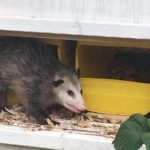
“Possum come aknockin’ at the door.”
“I went out in the afternoon a few weeks ago to look for eggs. I opened up the large door on the front of our coop, and in the nest box was something grey and furry and curled up in a little ball. My first thought was that it was a cat, but looking more closely it was definitely possum fur. I yelled and jumped a bit, and ran in to tell my husband and mother-in-law to come take a look. By the time we got back the possum had woken up. We opened up a little door we have at the back of the nest box and my mother in law encouraged the possum to jump down by prodding it with a broom from the front of the nest box. It jumped down and ran off. The opossum has come back a few times, and while it has not harmed our chickens, we are getting fewer eggs than we should be, and the possum has suspiciously glossy fur.”
by Winding Pathways | Oct 26, 2017 | Birds, Nature
This fall thousands of hunters will bring millions of ringneck pheasants home to be converted into delicious meals. Pheasants have been around so long that many people think of them as native birds. They’re not but they provide a lesson on how to structure a modern yard to attract wildlife.
In the 1880s Judge Owen Denny was stationed as a government agent in China. He and his wife took a fancy to colorful and tasty pheasants, which are native to Asia. They had some captured and shipped to Portland, Oregon where Denny’s brother released them on the family farm. They reproduced like crazy, and just ten years later Oregon opened the nation’s first pheasant season. About 50,000 were shot.
Pheasants began spreading out on their own and people speeded the process by capturing many and releasing them all over the country. The birds never took hold in the hot humid south but thrived in northern farmland that was a patchwork of grain and hayfields separated by brushy fence rows. By the mid-1900s they were abundant in the Midwest and eastward to the Atlantic wherever farms provided the right habitat.
Pheasants live near human activity. They love farmland yet shun forests. The bird did well until enormous changes in agriculture took place in recent years.
Because of rises in grain prices, huge increases in the size of agriculture machinery and fields, and modern pesticides farmers began tearing out the brushy fencerows the birds loved. As corn and soybean prices shot upward hayfields began to disappear. Pheasants lost safe places to nest.
Because of habitat loss pheasant populations are smaller than they once were but when habitat improves pheasant numbers swiftly rebound. It’s a good lesson for homeowners.
Pheasants generally aren’t backyard birds because most people live in shady suburban neighborhoods or big cities. Homeowners with yards backing up to farm fields might enjoy pheasant visits but otherwise, the birds are denizens of agricultural land.
However, pheasants provide a graphic example of the importance of habitat that applies to all species, including the loved and valued wildlife that lives in suburbia – or might if they find good living conditions. Chickadees, woodpeckers, goldfinches, cottontails, barred owls and dozens of other fascinating animals enjoy sharing yards with humans. If backyard habitat is improved they will come.
Here are a few ways to structure a yard, even a tiny one, to attract a variety of interesting wildlife:
- Create Diversity. Plant trees, shrubs, grasses and flowers that offer wildlife food and shelter. The greater the diversity of plants the greater the number of species that will take up residence.
- Shun Pesticides.
- Provide water. A tiny backyard pool or even birdbath will be appreciated by wildlife
Adding food might or might not help wildlife. It depends on what expert you consult, but adding a feeder certainly encourages wild animals, especially birds, to come close to the window so they can be seen. One of the very best seeds to put in the yard is black oil sunflower, which many species enjoy. The worst is milo, which is shunned by native species but devoured by House Sparrows. Corn is inexpensive and enjoyed by many wild animals.
An exciting and rewarding project is converting a sterile mowed and sprayed lawn into a wildlife haven. Pheasants probably won’t come but dozens of beautiful and interesting animals will.











 This fall we’ve noticed Osage Orange fruits for sale in grocery stores and roadside stands. They are fascinating and have a delightful fresh citrus scent.
This fall we’ve noticed Osage Orange fruits for sale in grocery stores and roadside stands. They are fascinating and have a delightful fresh citrus scent.